These Seared Ahi Tuna Steaks (also known as yellowfin or bigeye tuna) take only SIX MINUTES to cook to medium-rare perfection and are bursting with delicious umami flavor from the soy sauce and toasted sesame honey marinade recipe! And since marinating is optional, you can whip this tuna steak recipe up at a moment’s notice. I like serving these seared tuna steaks with rice and green beans, or simply over a bed of greens with an Asian-style salad dressing.
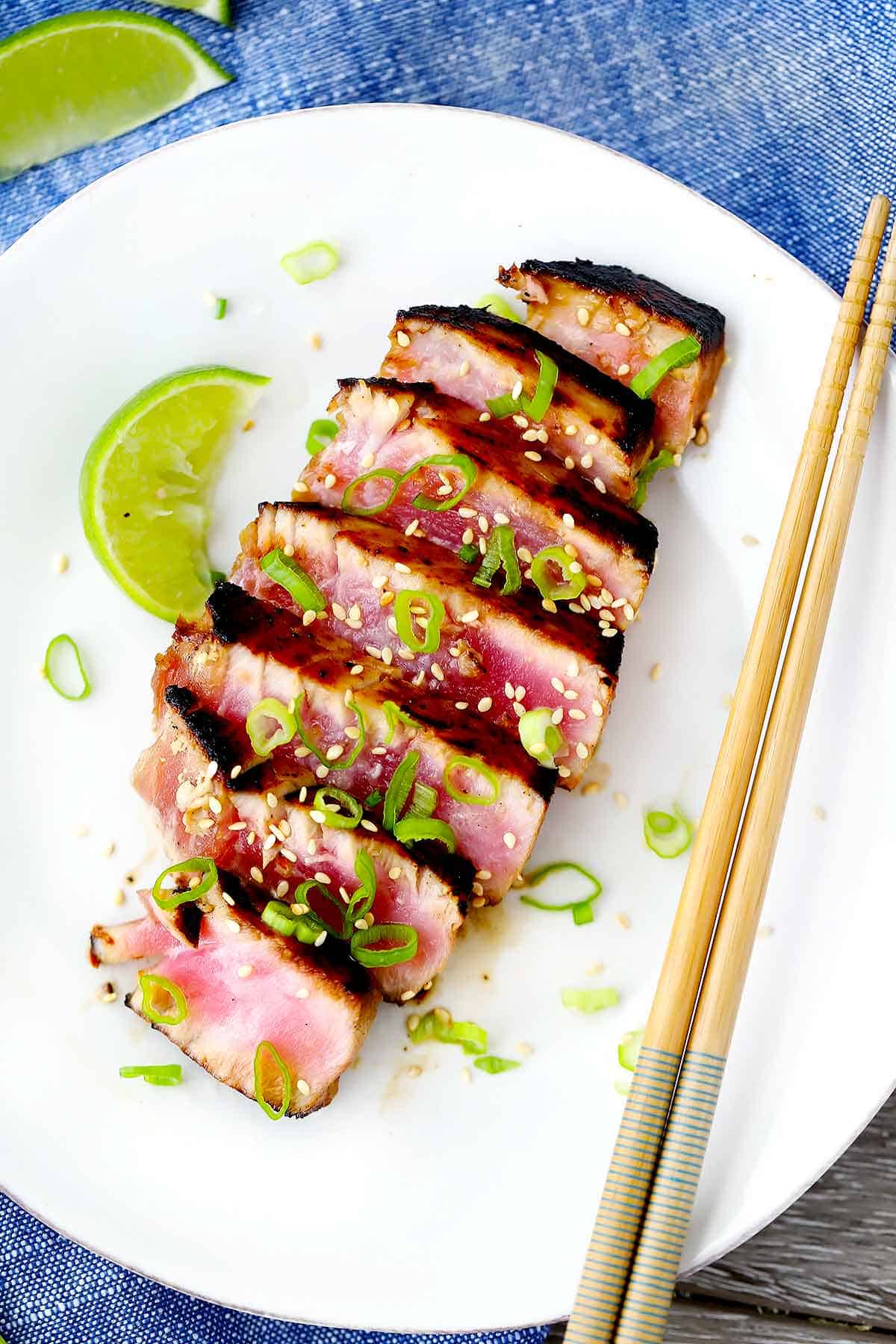
If I can get dinner on the table in less than 30 minutes, I’m a happy camper. Under 20? Even better. But under TEN? It’s almost too good to be true! But this one is DEFINITELY true.
So true that we’ve made these Six-Minute Seared Ahi Tuna Steaks twice in the past two weeks and fully plan on doing it again this coming week.
As you may have guessed from the title, this recipe only takes about six minutes, and it’s absolutely mouthwateringly delicious. And healthy. And EASY! What more could you want?
Fish in any form usually cooks up extremely quickly. Maybe that’s why I have so many salmon recipes on the blog. Like this Seared Salmon with Scallion Butter, and this 15-minute Poached Salmon with Chive Butter. And this Mandarin Orange Glazed Salmon!
Salmon is usually my go-to for fish, since it’s outrageously delicious and amazingly healthy.
But when I was at the grocery store the other day and saw these gorgeous ahi tuna steaks for $5 (that’s only $2.50 each!), I couldn’t resist.
What is Ahi Tuna?
Ahi tuna is type of tuna that is divided into two different species: yellowfin and bigeye. And it’s often cheaper than bluefin tuna, with a very similar flavor profile and texture. You can usually find it frozen at Trader Joe’s or your local grocery store for very inexpensive.
While I love salmon, it can be a bit pricey. And tuna, like salmon, is healthy and has an array of serious health benefits (including being high in Omega-3s and vitamin B12).
A seared tuna steak is a bit different than the canned tuna everyone is used to. For one thing: it comes in a whole, beautiful raw steak that holds its form much easier than other kinds of fish, which may tend to flake apart.
For another thing: it is usually cooked medium-rare: seared on the outside, red on the inside.
It actually looks very similar to a beef steak in this regard. It. Is. AMAZING.

Is it safe to eat raw ahi tuna?
If you’re nervous about eating raw fish, you should use your best judgement. You can always choose to cook these ahi tuna steaks all the way through to be well-done. There is always a risk to eating raw or undercooked seafood.
But tuna steaks are usually served seared on the outside and raw on the inside. Look up any seared ahi tuna recipe and you will see that it is almost always cooked this way. If you order it a restaurant, it’s bound to be cooked medium-rare as well.
If you’re looking for amazing flavor and texture, I personally think it’s worth the risk and I welcome you to jump on this bandwagon (unless you’re pregnant or have another medical reason not to consume raw fish – you should consult a physician if you’re concerned!). Fully cooked tuna can be a bit dry (like its canned counterpart), but when the outside is a crispy, salty, savory layer and the inside is a supple, soft, tender layer, it enhances the taste so much and the texture is amazing.
Plus, many of the bacteria that makes raw foods more risky to eat is usually found on the surface of the foods. If you sear the outside, as in this recipe, you’re killing off the bacteria that may make you sick. Same goes for a good seared steak.
Tuna, along with salmon, are fish that are least likely to have parasites, which is one of the reasons why you often see them served undercooked. If you buy sushi grade ahi tuna, it will have been frozen at a temperature which kills any potential parasites, so I recommend going this route just to be safe.
How to sear the tuna steaks
The fact that the tuna is served medium-rare accounts for its extremely fast cooking time. Just marinate the tuna in a mixture of soy sauce, oil, salt, and pepper (with some cayenne for some heat, if you want) preferably for at least ten minutes, or overnight.
For a typical ahi tuna steak (about 1.5″ thick), sear on each side for about two minutes (less time for rare; more time for medium). I recommend using a nonstick skillet for this, or a very well seasoned cast iron skillet (fish has a tendency to stick, and you don’t want to risk the beautiful seared outer layer sticking to the pan!).
Also, it’s important to get the pan SEARING hot before adding the fish. You want the outside to cook very quickly, while leaving the inside raw, so it should be as hot as possible before beginning to sear. I usually heat the pan for 3-5 minutes.
Let it rest for a few minutes, slice, and you’re ready!
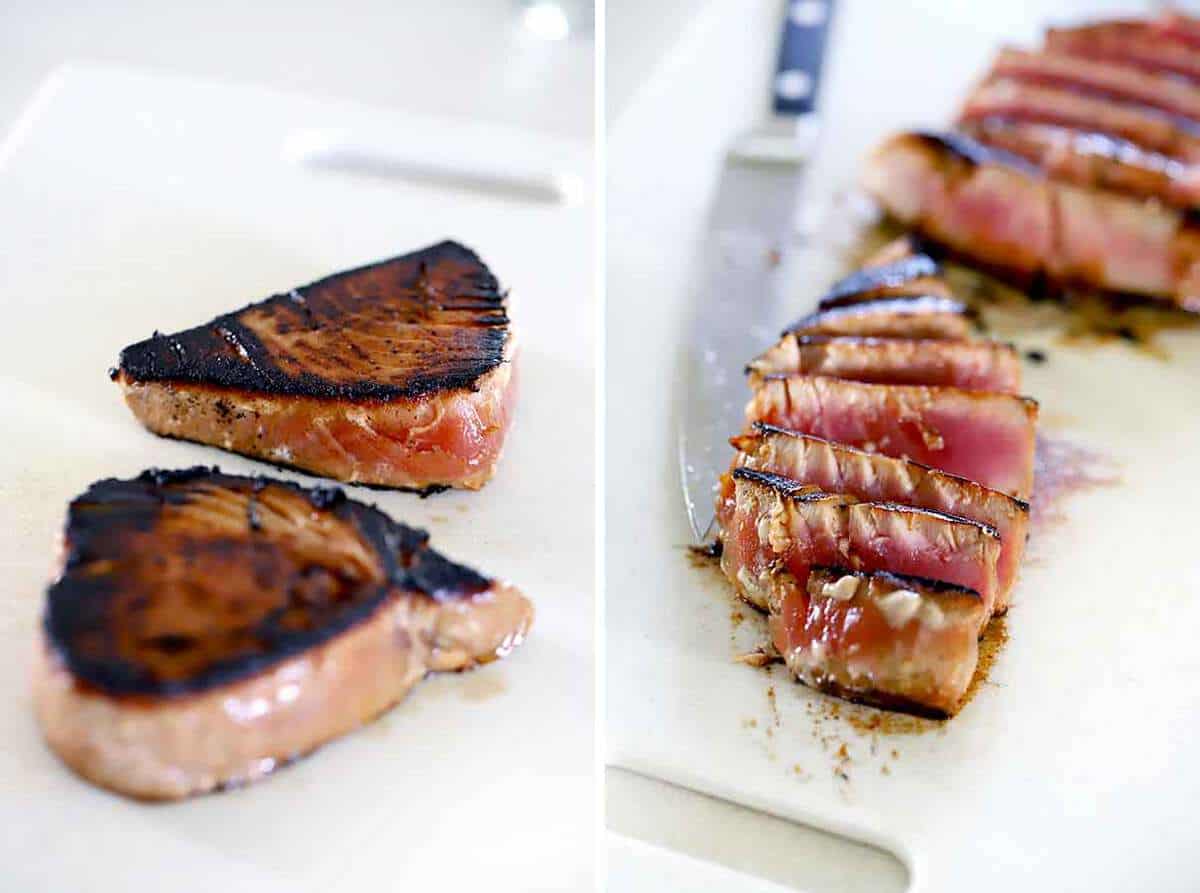
What to serve with ahi tuna
I like sprinkling some sliced green onions on top of the sliced ahi tuna, along with some toasted sesame seeds and a squeeze of fresh lime juice.
It’s DELICIOUS served in a rice bowl with green beans or broccoli and a drizzle of spicy mayo or other sauce.
Or, for a super healthy and low-carb meal, serve it on a bed of greens with an Asian-style dressing. (We used this soy-ginger one that was fabulous!).
Alternatively, this would be great in a seared tuna poke bowl. Poke bowls are usually made with raw fish, but I think this fish, seared perhaps for a little less time than normal, cut up into cubes, would be excellent in a poke bowl.
I think this sliced tuna steak would be amazing on top of avocado toast, too!
How to thaw frozen fish
I bought my ahi tuna steaks frozen, but you may be able to find fresh. If you use frozen, just make sure it’s completely defrosted before cooking.
I usually take mine out of the vacuum sealed plastic and leave it on a plate, covered in plastic wrap, in the fridge for 24 hours before I plan on cooking. Then, I make sure to pat them dry before cooking, as this will create a better sear.
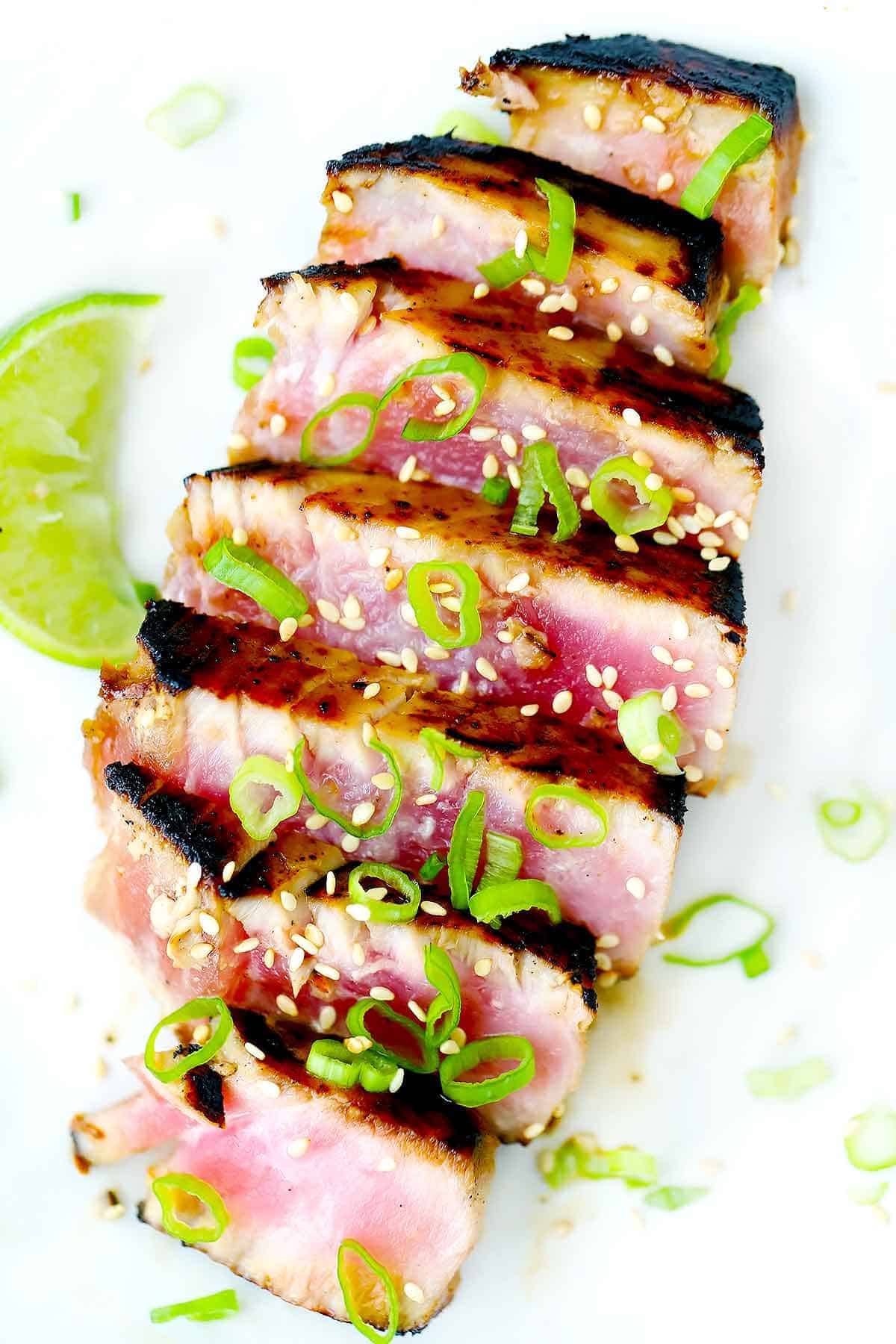
Other easy fish recipes
- Four-Ingredient Southern Style Oven Fried Catfish
- Garlic Butter Sheet Pan Salmon and Veggies
- New England Baked Haddock
- 10-Minute Blackened Tilapia with Avocado Cucumber Salsa
- Pan Fried Sea Bass with Lemon Garlic Herb Sauce
Love how quick and easy seafood is? Check out all my seafood recipes!
Did you make this Seared Ahi Tuna Steak Recipe? Please comment below and Rate this Recipe
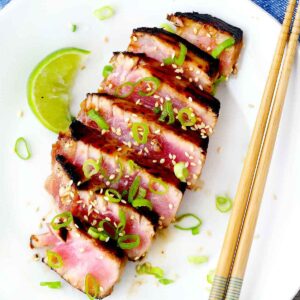
Six-Minute Seared Ahi Tuna Steaks
Equipment
Ingredients
- 2 ahi tuna (yellowfin tuna) steaks (about 4 oz. each, 1" thick – see notes for thinner or thicker)
- 2 tablespoons soy sauce
- 1 tablespoon toasted sesame oil see notes
- 1 tablespoon honey see notes
- 1/2 teaspoon kosher salt
- 1/4 teaspoon black pepper to taste
- 1/4 teaspoon cayenne pepper (optional)
- 1 tablespoon canola oil or olive oil
- green onions, toasted sesame seeds, and lime wedges for serving (optional)
Instructions
- Pat the ahi tuna steaks dry with a paper towel. Place on a plate or inside a plastic bag.
- Mix the soy sauce (2 tablespoons), toasted sesame oil (1 tablespoon), honey (1 tablespoon) kosher salt (1/2 teaspoon- OMIT if marinating for more than a couple hours, see notes), pepper (1/4 teaspoon), and cayenne pepper (1/4 teaspoon) until honey is fully dissolved. Pour over the ahi tuna steaks and turn over to coat completely. Optional: allow to marinate for at least 10 minutes, or up to overnight in the refrigerator. Also optional: Reserve a spoonful or two of the marinade before coating the fish for drizzling on top after you've cooked it.
- Heat a medium skillet (preferably non-stick or a well-seasoned cast iron skillet) on medium-high to high until very hot ( or medium medium-high for nonstick). I recommend giving cast iron 3-5 minutes to get hot and nonstick about 1 minute, depending on how thick it is.
- Add the canola oil (1 tablespoon) to the hot pan. Sear the tuna for 1 – 1½ minutes on each side for medium rare ( 2 -2½ minutes for medium-well to well, 30 seconds for very rare. See notes – this will vary based on thickness of the tuna steaks). (Note: different burners get hotter depending on your stove. Use your best judgement whether you use medium, medium-high, or high heat, as the marinade may burn if too high heat is used)
- Remove to a cutting board. Slice into 1/2 inch slices and serve garnished with green onions, toasted sesame seeds, and a squeeze of fresh lime juice, if desired.
Notes
- For thinner or thicker tuna steaks, you may need less or more searing time. If you are using tuna steaks that are less than 1 inch, I recommend no more than 1 minute per side, depending on your preference for doneness. For thicker steaks, you may need to do 2 minutes per side. You may also need less searing time depending on the temperature of your fish- if it’s been sitting out of the fridge for a while, it will take less time to cook.
- This recipe has been updated from its original. It had a simpler marinade of 2 tablespoons soy sauce, 1 tablespoon canola oil, salt, and pepper before. If you’re short on ingredients (like toasted sesame oil and honey) try this simpler version!
- For a gluten-free version, be sure to use gluten-free soy sauce. Or, for a paleo/whole30 compliant option, use liquid aminos instead.
- Depending on how hot your burners are, you may have to experiment with how long to sear each side. Depending on the stove I’m using, I sometimes only cook it for one minute on each side for medium-rare!
- You can also grill this over hot coals or high heat on a gas grill for about 1 minute per side.
- Marinating for a while can cause the fish to taste saltier, as it will have more time to absorb the flavor. If you’re planning on marinating for more than an hour or so, or if you are sensitive to salt or want a lower sodium version, I suggest omitting the kosher salt and/or using low-sodium soy sauce.
- Carryover cooking will occur if you let your tuna rest for too long after cooking. Slicing it immediately will result in a more rare temperature, and letting it rest before slicing will cook it further.
- There is always a risk when eating raw or undercooked seafood. Tuna, along with salmon, are fish that are least likely to have parasites, which is one of the reasons why you often see them served undercooked. If you buy sushi grade ahi tuna, it will have been frozen at a temperature which kills any potential parasites, so I recommend going this route just to be safe. Please talk to a medical professional if you have concerns about this.
Nutrition
Nutrition Information Disclaimer
The provided nutrition information is my best estimate and does not include any added sodium from seasoning to taste, any optional ingredients, and it does not take brands into account. I use an automatic API to calculate this information. Feel free to calculate it yourself using one of these tools:
This recipe first appeared on Bowl of Delicious in November 2015. The recipe has been modified to be even more delicious, and the post updated with more pertinent information and new photos. See recipe notes for original recipe ingredients.


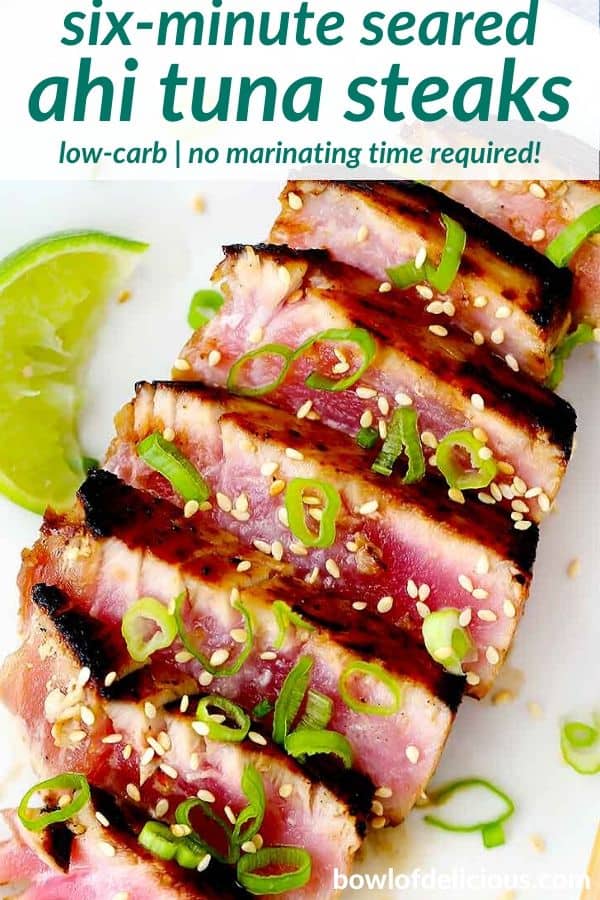
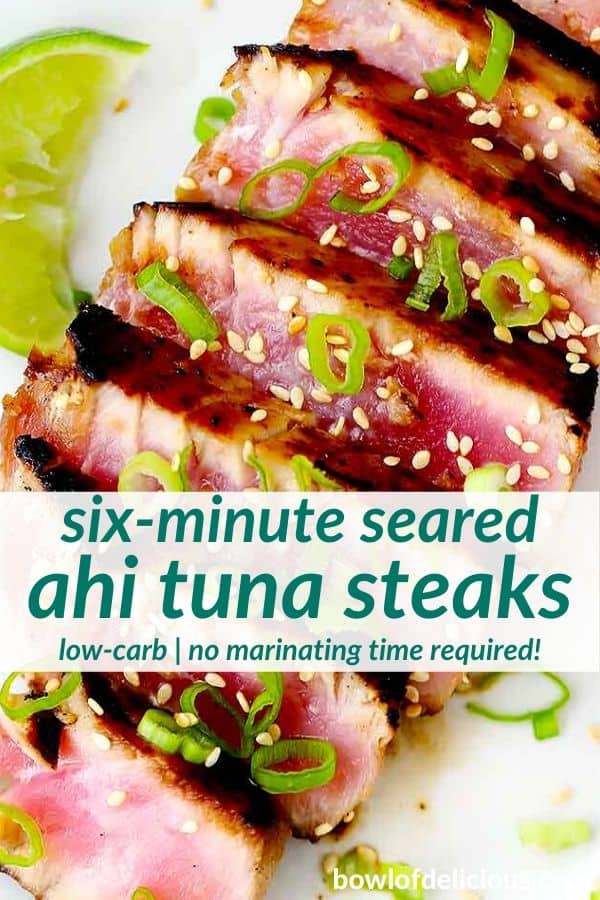
Daniel Dufort
Very Easy recipe and delicious. Highly recommend.
Elizabeth Lindemann
So glad you liked it!
Richard Mears
First time making this, it was very good. Will start buying ahi tuna more often. Thank You!!
Elizabeth Lindemann
So glad you liked it!